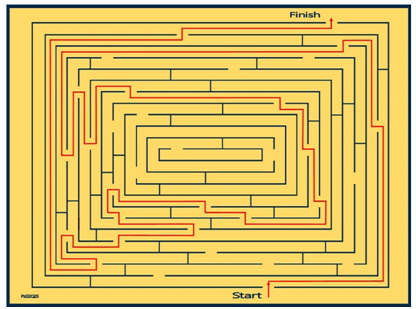Manageria
» July 2025
» Jan 2025
» July 2024
» Jan 2024
» July 2023
» Jan 2023
» Oct 2022
» July 2022
» Apr 2022
» Jan 2022
» Oct 2021
» July 2021
» Apr 2021
» Jan 2021
» Oct 2020


Add To What You Know
Prepared by: "Optimanage.com"
Calculating a Projected Profit for a Production Operation (1) (2)
The Projected Profit for a production operation can be determined by using the elements available in the BEQ formula (1) (2). So, Profit is the difference between Total Revenue and Total Costs, in other words it is:| Profit | = Total Revenue (TR) - Total Costs (TC) | ……… (1) |
| Profit | = TR - TC | ……. (1a) |
| = (P x Q) – [(VC x Q) + FC] | …… (2) | |
| = PQ – VCQ – FC | ……. (3) | |
| = Q (P – VC) – FC | …… (4) |
| Profit | = Total Revenue (TR) - Total Costs (TC) | ……… (1) |
| Profit | = TR - TC | ……. (1a) |
| = (P x Q) – [(VC x Q) + FC] | …… (2) | |
| = PQ – VCQ – FC | ……. (3) | |
| = Q (P – VC) – FC | …… (4) |
| Where, | P = Price of Unit | Q = Quantity Sold |
| VC = Variable Cost | FC = Fixed Costs |
| Where, | P = Price of Unit | Q = Quantity Sold |
| VC = Variable Cost | FC = Fixed Costs |
To illustrate the application of the above relationship, let us consider an example where:
| FC = $ 11,000 | P = $ 9.00/unit |
| VC = $ 6.00/unit | Q = 4,000 units sold |
| FC = $ 11,000 | P = $ 9.00/unit |
| VC = $ 6.00/unit | Q = 4,000 units sold |
Using the above equation (4) projected profit can be calculated:
| Profit | = Q (P – VC) – FC | …… (4) |
| = 4,000 ($ 9 - $ 6) - $ 10,000 | ||
| = 4,000 ($ 3) - $ 11,000 | ||
| = $ 12,000 - $ 11,000 | ||
| = $ 1,000 |
| Profit | = Q (P – VC) – FC | …… (4) |
| = 4,000 ($ 9 - $ 6) - $ 10,000 | ||
| = 4,000 ($ 3) - $ 11,000 | ||
| = $ 12,000 - $ 11,000 | ||
| = $ 1,000 |
This same equation can be used to make go/no go decisions regarding buying any new machinery.
Taking the above situation, a little further, and considering the case where a company’s management is evaluating the purchase of a new machine for its factory. The new machine is expected to add $ 5,000 to the fixed costs with no beneficial effects. It will allow an increase in production by 5% and it will reduce the costs/unit by $ 1.
Then,
| The Increase in Production (10%) | = 4,000 x (5/100) |
| = 4,000 x 0.05 | |
| = 200 units | |
| The potential Total Production (Q) | = 4,000 + 200 |
| = 4,200 units | |
| The potential Variable Cost/unit (VC) | = $ 6 - $1 |
| = $ 5 | |
| The potential Fixed Costs (FC) | = $ 11,000 + $ 5,000 |
| = $ 16,000 |
| The Increase in Production (10%) | = 4,000 x (5/100) |
| = 4,000 x 0.05 | |
| = 200 units | |
| The potential Total Production (Q) | = 4,000 + 200 |
| = 4,200 units | |
| The potential Variable Cost/unit (VC) | = $ 6 - $1 |
| = $ 5 | |
| The potential Fixed Costs (FC) | = $ 11,000 + $ 5,000 |
| = $ 16,000 |
The unit price (P) does not change from what it was in the original situation, therefore:
| The Price/unit (P) | = $ 9/unit |
| The Price/unit (P) | = $ 9/unit |
The question facing management is to decide to buy or not to buy the new machine. To make such decision (a go/no go decision), calculating the potential profitability (Profit1) of this purchase is needed.
Using the same equation (4) along with the above calculated values, the projected potential profit can be determined:
| Profit¹ | = Q (P – VC) – FC | …… (4) |
| = 4,200 ($ 9 - $ 5) - $ 16,000 | ||
| = 4,200 ($ 4) - $ 16,000 | ||
| = $ 16,800 - $ 16,000 | ||
| = $ 800 |
| Profit¹ | = Q (P – VC) – FC | …… (4) |
| = 4,200 ($ 9 - $ 5) - $ 16,000 | ||
| = 4,200 ($ 4) - $ 16,000 | ||
| = $ 16,800 - $ 16,000 | ||
| = $ 800 |
Comparing the two projected profits (Profit and Profit¹):
Profit = $ 1,000
Profit¹ = $ 800
It is clear that the present arrangement Profit ($ 1,000) is higher than the proposed arrangement Profit1 ($800). Therefore, it is not necessary to purchase the machine.
The above technique is useful only when deciding between two possibilities.
References:
(1) Patrick J. Montana and Bruce H. Charnov, “Management”, Business Review Books, Third Edition, Baron’s (2000), p 392-393.
(2) optimanage.com, Add to What You Knowoptimanage.com, Manageria, Optimanage.com, Quarter 1 (2022), p 5.





